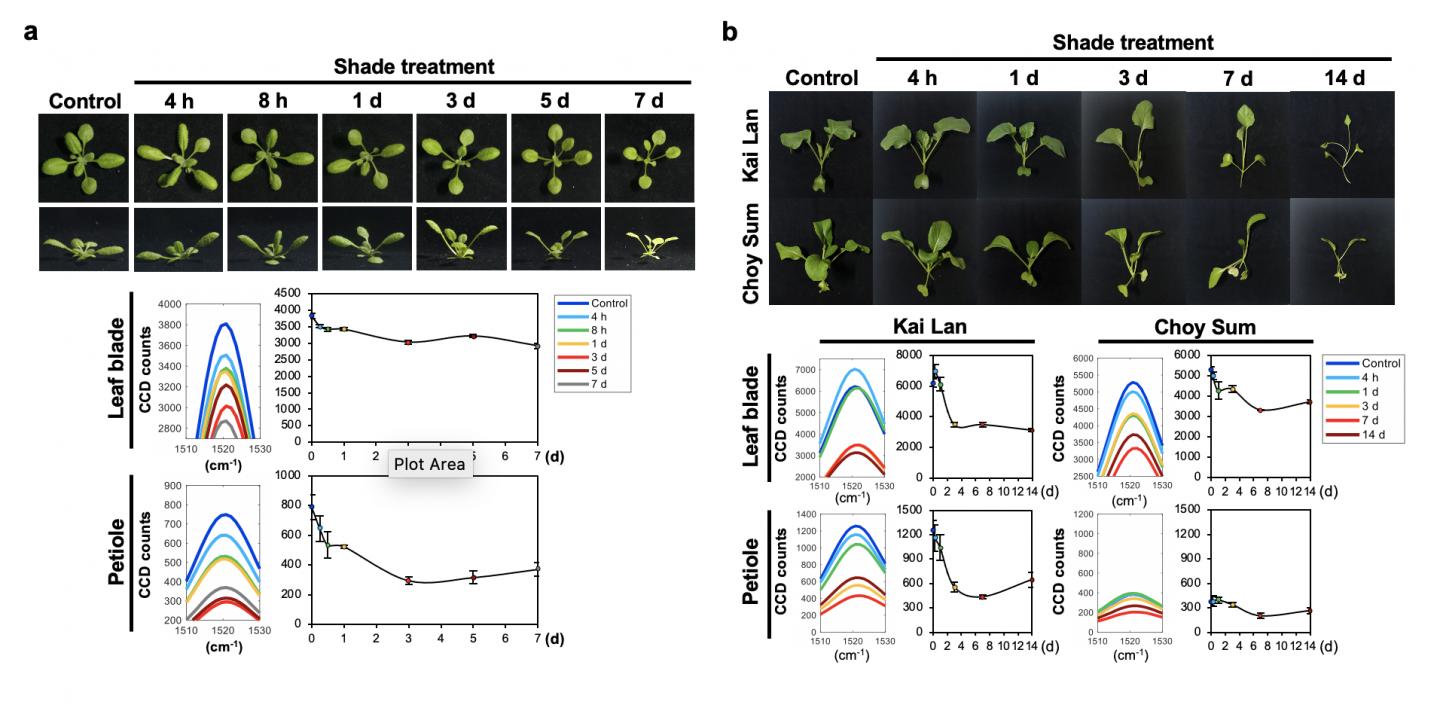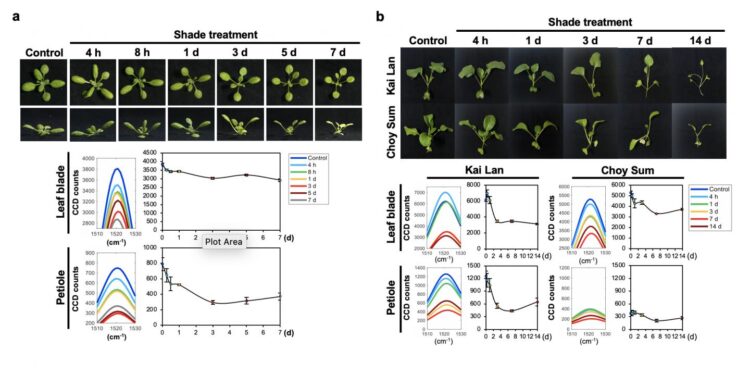Researchers use Raman spectroscopy for early detection of SAS, which can help farmers better monitor plant health and lead to improved crop yield

Credit: Singapore-MIT Alliance for Research and Technology
- Negative effects of shade avoidance syndrome (SAS), where plants reach for more light to overcome shaded conditions, are irreversible and early detection is crucial for sustainable agricultural practices
- Study found Raman spectroscopy can detect SAS in plants within a few hours, while conventional methods rely on morphological changes that can take one to three days
- New method can be widely applied across various plant species and crops
Singapore, 25 November 2020 – Researchers from the Disruptive & Sustainable Technologies for Agricultural Precision (DiSTAP) Interdisciplinary Research Group (IRG) of Singapore-MIT Alliance for Research and Technology (SMART), MIT’s research enterprise in Singapore and Temasek Life Sciences Laboratory (TLL) have discovered a way to use Raman spectroscopy for early detection of shade avoidance syndrome (SAS) in plants. The discovery can help farmers with timely intervention against SAS, leading to better plant health and crop yield.
SAS is an adaptive response and an irreversible phenomenon, where plants reach for more light to overcome shaded conditions. It is commonly seen in plants experiencing vegetative shade which is detrimental to plant health, as it leads to a number of issues including hindrance of leaf development, early flowering and weakening of the plant’s structure and immune system.
Thus, early detection of SAS is key for sustainable agriculture and improved crop yield. However, existing methods for detection of SAS in plants are restricted to observing structural changes, making it difficult to detect SAS early.
In a paper titled “Rapid metabolite response in leaf blade and petiole as a marker for shade avoidance syndrome” published in the prestigious journal Plant Methods, SMART DiSTAP and TLL scientists explain their new way of detecting SAS early on, allowing farmers to intervene in time to prevent the irreversible effects of SAS. The team built a tabletop Raman spectroscopy instrument that allows measurement of carotenoid levels in plants, which can indicate whether a plant has SAS.
“Our experiments with Raman spectroscopy detected a decrease in the carotenoid contents of plants that have SAS,” said Dr Gajendra Pratap Singh, co-first author of the paper and Scientific Director and Principal Investigator at DiSTAP. “While plants with longer exposure to shade developed more severe SAS, these morphological changes were only seen after one to three days. However, changes in the carotenoid peak intensities were detected much earlier, from just four hours of shade treatment.”
Using Raman spectroscopy, the scientists are able to non-destructively measure carotenoid content in the plant leaves, and have discovered its correlation to the severity of SAS and as a peak biomarker for early diagnosis. This cuts down the time taken to detect SAS from days to a matter of hours. The method can also be used to detect SAS in plants due to high-density planting and can be particularly useful to improve urban farming practices.
“We conducted our experiments on a number of edible plants, including frequently consumed Asian vegetables like Kai Lan and Choy Sum,” said Mr Benny Jian Rong Sng, the paper’s co-first author and PhD student from Dr In-Cheol Jang’s group at TLL and Department of Biological Sciences, National University of Singapore. “Our results showed that Raman spectroscopy can be used to detect SAS, induced by shade as well as high-density planting. Regardless of the food crop, this technology can be applied to improve agriculture and to meet the nutritional demands of today’s growing populations.”
Dr In-Cheol Jang, Principal Investigator at TLL and DiSTAP, who led the project said the novel discovery can go a long way in assisting farmers to improve urban farming practices. “We look forward to helping urban farmers achieve higher crop yields by detecting SAS within shorter time periods. By adopting scalable, precision agri-technologies like Raman spectroscopy-enabled sensors, we can better position cities like Singapore to grow more produce with less resources, while achieving desirable nutritional profiles for global food security.”
###
DiSTAP co-lead Principal Investigator Professor Chua Nam Hai and Principal Investigator Professor Rajeev Ram also co-authored the article.
The research was supported by the National Research Foundation (NRF) Singapore under its Campus for Research Excellence And Technological Enterprise (CREATE) programme.
About SMART Disruptive & Sustainable Technologies for Agricultural Precision (DiSTAP)
DiSTAP is one of the five Interdisciplinary Research Groups (IRGs) of the Singapore-MIT Alliance for Research and Technology (SMART). The DiSTAP programme addresses deep problems in food production in Singapore and the world by developing a suite of impactful and novel analytical, genetic and biosynthetic technologies. The goal is to fundamentally change how plant biosynthetic pathways are discovered, monitored, engineered and ultimately translated to meet the global demand for food and nutrients. Scientists from Massachusetts Institute of Technology (MIT), Temasek Life Sciences Laboratory (TLL), Nanyang Technological University (NTU) and National University of Singapore (NUS) are collaboratively: developing new tools for the continuous measurement of important plant metabolites and hormones for novel discovery, deeper understanding and control of plant biosynthetic pathways in ways not yet possible, especially in the context of green leafy vegetables; leveraging these new techniques to engineer plants with highly desirable properties for global food security, including high yield density production, drought and pathogen resistance and biosynthesis of high-value commercial products; developing tools for producing hydrophobic food components in industry-relevant microbes; developing novel microbial and enzymatic technologies to produce volatile organic compounds that can protect and/or promote growth of leafy vegetables; and applying these technologies to improve urban farming.
The DiSTAP IRG at SMART is led by MIT co-lead Principal Investigator Professor Michael Strano and Singapore co-lead Principal Investigator Professor Chua Nam Hai.
For more information, please log on to:
http://distap.
About Singapore-MIT Alliance for Research and Technology (SMART)
Singapore-MIT Alliance for Research and Technology (SMART) is MIT’s Research Enterprise in Singapore, established by the Massachusetts Institute of Technology (MIT) in partnership with the National Research Foundation of Singapore (NRF) since 2007. SMART is the first entity in the Campus for Research Excellence and Technological Enterprise (CREATE) developed by NRF. SMART serves as an intellectual and innovation hub for research interactions between MIT and Singapore. Cutting-edge research projects in areas of interest to both Singapore and MIT are undertaken at SMART. SMART currently comprises an Innovation Centre and five Interdisciplinary Research Groups (IRGs): Antimicrobial Resistance (AMR), Critical Analytics for Manufacturing Personalized-Medicine (CAMP), Disruptive & Sustainable Technologies for Agricultural Precision (DiSTAP), Future Urban Mobility (FM) and Low Energy Electronic Systems (LEES).
SMART research is funded by the National Research Foundation Singapore under the CREATE programme. For more information, please visit – http://smart.
For media queries, please contact:
Tazkira Sattar
[email protected]
+65 8280 3055
Media Contact
Tazkira Sattar
[email protected]
Original Source
https:/
Related Journal Article
http://dx.





